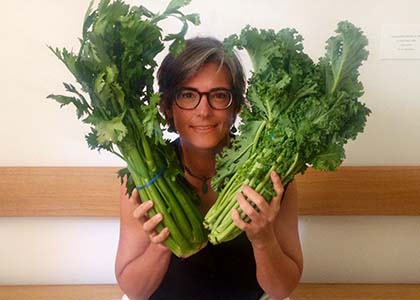
3 Budget-Friendly Tips from My Cheap Reboot
By Christine Frietchen
Sticker shock is relatively common when it comes to Rebooting. When you’re armed with a shopping list of fruits and veggies, buying groceries all at once for a 5-Day Reboot can add up. But Rebooting doesn’t have to empty your wallet.
I used my recent 5-Day Reboot (in the Reboot with Joe Juice Diet Book) as a test case to see just how little I could spend. Keep in mind this is New York City, a city known for its high cost-of-living. The first step was determining what I spend on food for 5 days normally, so I’d be comparing apples to apples.
I already consume a plant-based diet, so I figured my weekly food costs were pretty low to begin with, but I had not recently actually done the math. I normally pick up breakfast on the way to work: a container of steel-cut oats for $3. Then I add my own fresh fruit and almonds. I make big dinners so I can take leftovers to work for lunch, spending about $20 on vegetables and another $10 on fruit for the workweek. Adding in canned beans, lentils, quinoa, nuts and a little tofu brings me to a total of $62, or $12.40 per day, and that’s without eating out, or grabbing a snack or a cup of tea here and there.
The total spend for my 5-day Reboot: $58, or $11.60 per day. Outside of New York City, I’m sure my costs could have been $15 or $20 less. Here’s how I kept my Reboot grocery bill as low as possible.
- Go for cheaper substitutions.
Jicama is on the 5-Day Reboot shopping list in the Reboot with Joe Juice Diet book, but jicama is hard to find and pricey. Using the substitution list in the book, I went with much-cheaper celery instead. And several recipes called for handfuls of any greens. I bought whatever greens were on sale. I was able to find huge bunches of kale at 2 for $5. They were so large that I only needed 3 bunches for the week, instead of the 5 bunches on the shopping list. - Don’t buy everything in one place.
I bought what I could at Trader Joe’s. For example, they usually have a great deal on some kind of apples, typically a 3-pound bag for $2. Same for oranges. But I found the best deals on in-season greens and veggies at the farmer’s market. That’s where I found my great deal on kale and Swiss chard. I also found inexpensive peaches and cucumbers. - Buy organic selectively.
In a perfect word, sure I’d buy all my produce organic. But the sad reality is that organic items still cost significantly more. So I tried to buy the Environmental Working Group’s “Dirty Dozen” organic, including kale, apples, celery, and peaches. Everything else I bought conventional.
There are more strategies I didn’t try that might have lowered my costs even further. I could have tried visiting farmer’s markets late in the day to snap up leftover produce at a discount.
Bulk stores like Costco or Sam’s Club could have saved me some money, but neither was available to me.
I’d love to hear your tips on saving money on grocery bill, especially from those in other parts of the country! As Joe says, “Juice On!”
You might also find this article helpful: 5 Tips to Juice a Mean Green on a Budget